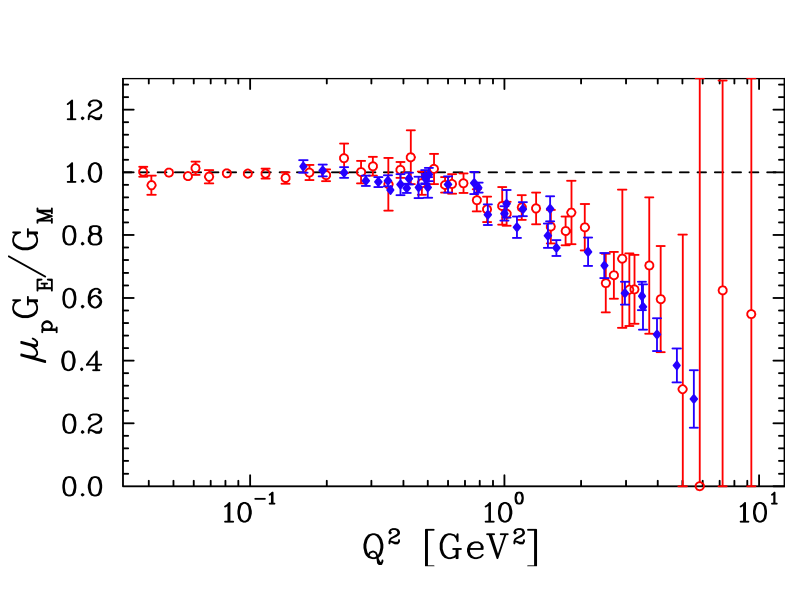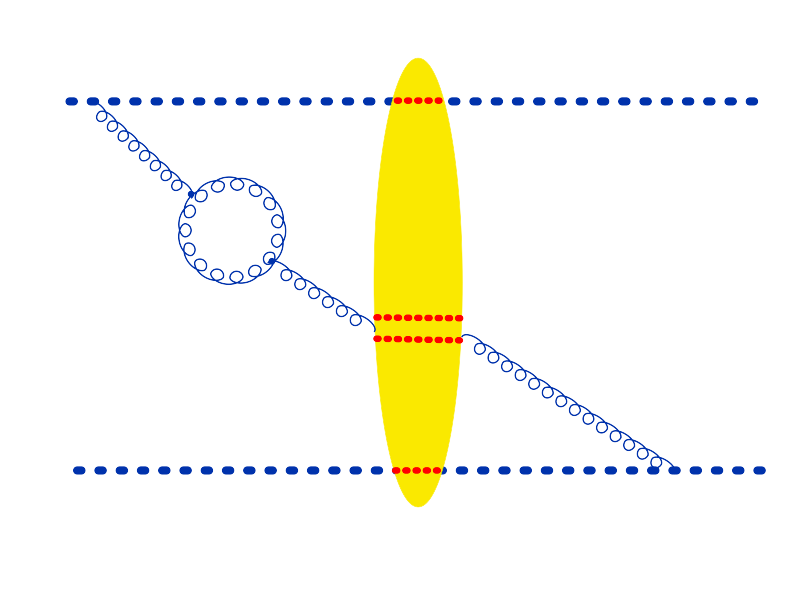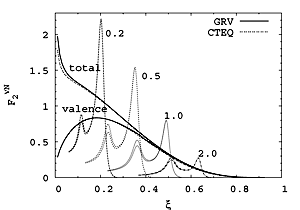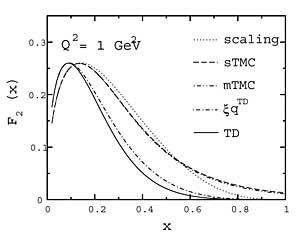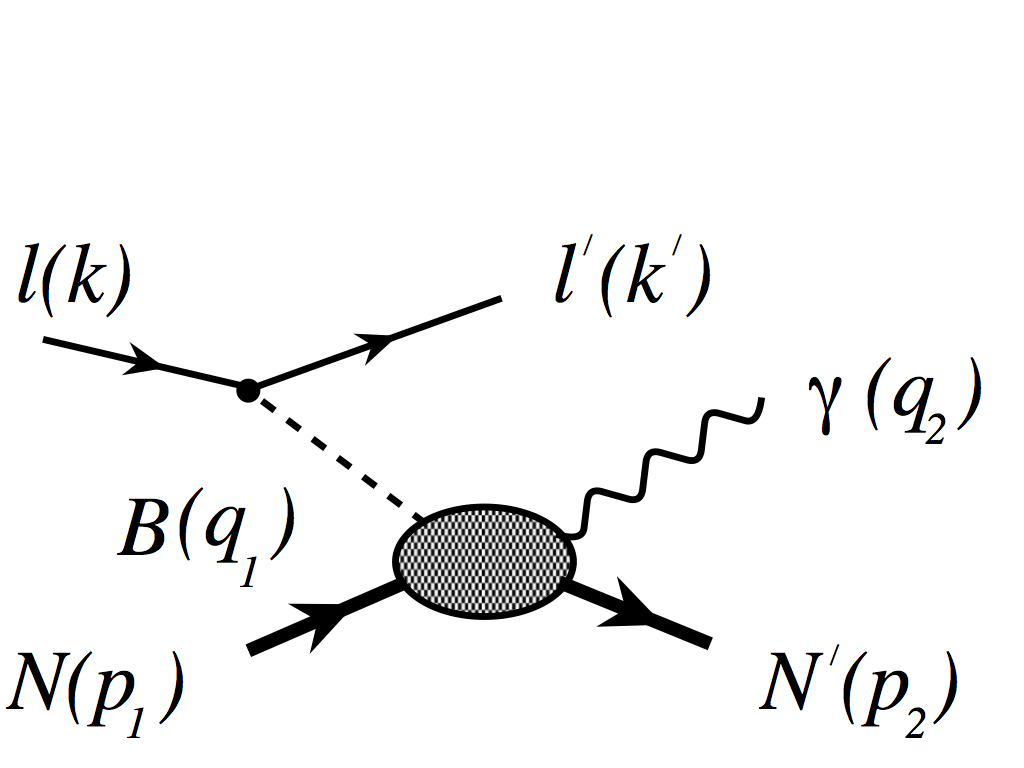Theory Center Research Highlights
Hadron Form Factors and Quark-Gluon Distributions
Form Factors
Structure Functions
Generalized Parton Distributions
Form Factors
"Review of two-photon exchange in electron scattering"
J. Arrington, P. G. Blunden, W. Melnitchouk
Prog. Part. Nucl. Phys. 66, 782 (2011)
The role of two-photon exchange (TPE) in electron-hadron scattering is
reviewed, with particular focus on hadronic frameworks suitable for
describing the low and moderate Q2 region relevant to
most experimental studies. The effects of TPE on the extraction of nucleon
form factors is discussed, together with their role in the resolution
of the proton electric to magnetic form factor ratio puzzle. The
implications of TPE on various other observables, including neutron form
factors, electroproduction of resonances and pions, and nuclear form
factors, are summarized.
Measurements seeking to directly identify TPE effects, such as through the
angular dependence of polarization measurements, nonlinear epsilon
contributions to the cross sections, and via e+p
to e-p cross section ratios, are also outlined.
"Global analysis of proton elastic form factors data with two-photon
exchange corrections"
J. Arrington, W. Melnitchouk and J.A. Tjon
Phys. Rev. C 76, 035205 (2007)
Using the world's data on elastic electron-proton scattering and calculations of two-photon exchange effects, corrected values of the proton's electric and magnetic form factors are extracted over the full Q2 range of the existing data. The analysis combines the corrected Rosenbluth cross section and polarization transfer data, and is the first extraction of GEp and GMp including explicit two-photon exchange corrections and their associated uncertainties. In addition, the angular dependence of the corrected cross sections is examined, and the possible nonlinearities of the cross section discussed as a function of ε.
"Chiral extrapolation of nucleon magnetic form factors"
P. Wang, D. B. Leinweber, A. W. Thomas, R. D. Young
Phys. Rev. D 75, 073012 (2007)
The extrapolation of nucleon magnetic form factors calculated in lattice QCD is investigated within a framework based on heavy baryon chiral effective field theory. All one-loop graphs are considered at arbitrary momentum transfer and all octet and decuplet baryons are included in the intermediate states. Finite range regularization is applied to improve the convergence in the quark-mass expansion. At each value of the momentum transfer Q2, a separate extrapolation to the physical pion mass is carried out as a function of mπ alone. Because of the large values of Q2 involved, the role of the pion form factor in the standard pion-loop integrals is also investigated. The resulting values of the form factors at the physical pion mass are compared with experimental data as a function of Q2 and demonstrate the utility and accuracy of the chiral extrapolation methods.
Structure Functions
Results of the CTEQ6X fit for the u- and d-quark distributions with expanded kinematics and inclusion of TMC, HT and nuclear corrections, normalized to the earlier global CTEQ6.1 PDFs. The vertical lines show the approximate values of x above which PDFs are not directly constrained by data. The error bands correspond to Δχ=1.
"New parton distributions from large-x and low-Q2
data"
A. Accardi, M. E. Christy, C. E. Keppel, W. Melnitchouk,
J. Morfin, P. Monahan, J. Owens
Phys. Rev. D 81, 034016 (2010)
A new global next-to-leading order fit of parton distribution functions is performed in which cuts on W and Q are relaxed, thereby including more data at high values of x. Effects of target mass corrections (TMCs), higher twist contributions, and nuclear corrections for deuterium data are significant in the large-x region. The leading twist parton distributions are found to be stable to TMC model variations as long as higher twist contributions are also included. The behavior of the d quark as x → 1 is particularly sensitive to the deuterium corrections, and using realistic nuclear smearing models the d-quark distribution at large x is found to be softer than in previous fits performed with more restrictive cuts. Application of the results of the CTEQ6X analysis will help constrain the uncertainty in computing QCD backgrounds in searches for new physics beyond the Standard Model in collider experiments, and the analysis of neutrino oscillation experiments.
Extracted neutron F2n structure function at Q2 = 1.7 and 5 GeV2, together with proton and deuteron data, and the reconstructed deuteron. The proton and neutron data are compared with the global QCD fit from Alekhin et al. The dependence of the iteration on the initial value is illustrated in the insert.
"Confirmation of quark-hadron duality in the neutron F2
structure function"
S. P. Malace, Y. Kahn, W. Melnitchouk, C. E. Keppel
Phys. Rev. Lett. 104, 102001 (2010)
A recently developed extraction technique is applied to obtain for the first time the neutron F2n structure function from inclusive proton and deuteron data in the nucleon resonance region, and test the validity of quark-hadron duality in the deutron. The accuracy of duality in the low-lying neutron resonance regions is established over a range of Q2, and results compared with the corresponding results on the proton and with theoretical expectations. The confirmation of duality in both the neutron and proton opens the possibility of using resonance region data to constrain parton distributions at large x.
"Quark-hadron duality and truncated moments of nucleon structure
functions"
A. Psaker, W. Melnitchouk, M. E. Christy, C. Keppel
Phys. Rev. C 78, 025206 (2008)
A novel new approach is employed to study local quark-hadron duality using "truncated" moments, or integrals of structure functions over restricted regions of x, to determine the degree to which individual resonance regions are dominated by leading twist. Because truncated moments obey the same Q2 evolution equations as the leading twist parton distributions, this approach makes possible for the first time a description of resonance region data and the phenomenon of quark-hadron duality directly from QCD.
"Next-to-leading order evolution of color dipoles"
I. Balitsky, G.A. Chirilli
Phys. Rev. D 74, 014001 (2007) &
Phys. Rev. D 77, 014019 (2008)
Deep inelastic scattering in the saturation region (for small x and/or large nucleus) is described by the evolution of color dipoles. In the leading order this evolution is governed by the non-linear Balitsky-Kovchegov (BK) equation. To see if this equation is relevant for existing or future accelerators (like the Electron Ion Collider) one needs to know how large are the next-to-leading order (NLO) corrections. In addition, the NLO corrections define the scale of the running coupling constant in the BK equation and therefore determine the magnitude of the leading-order cross sections.
"Quark-hadron duality in neutrino scattering"
O. Lalakulich, W. Melnitchouk, E.A. Paschos
Phys. Rev. C 75, 015202 (2007)
A phenomenological model of the quark-hadron transition in neutrino-nucleon scattering is presented. Using recently extracted weak nucleon transition form factors, the extent to which local and global quark-hadron duality is applicable in the neutrino F1, F2 and F3 structure functions is investigated, and contrasted with duality in electron scattering. The findings suggest that duality works relatively well for neutrino-nucleon scattering for the F2 and F3 structure functions, but not as well for F1. The quasi-elastic, resonance and deep inelastic contributions to the Adler sum rule are also calculated, and found to be satisfied to within 10% for 0.5 < Q2 < 2 GeV2.
"Target mass corrections revisited"
F.M. Steffens, W. Melnitchouk
Phys. Rev. C 73, 055202 (2006)
A new implementation of target mass corrections (TMCs) to nucleon structure functions is proposed, which, unlike existing treatments, has the correct kinematic threshold behavior at finite Q2 in the x -> 1 limit. The differences between the new approach and existing prescriptions are illustrated by considering specific examples for the F2 and FL structure functions, and the broader implications of the results are discussed, which call into question the notion of universal parton distribution at finite Q2.
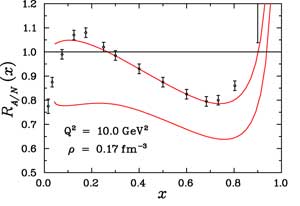
Ratios of the spin-independent and spin-dependent nuclear to nucleon structure functions at nuclear matter density. The upper curve is the ratio of unpolarized isoscalar F2 structure functions in medium and in free space, compared with data which have been extrapolated from finite nuclei to nuclear matter. The lower curve is the ratio of the polarized proton g1 structure function in medium and in free space.
"Spin-dependent structure functions in nuclear matter and the polarized
EMC effect"
I.C. Cloet, W. Bentz, A.W. Thomas
Phys. Rev. Lett. 95, 052302 (2005)
An excellent description of both spin-independent and spin-dependent quark distributions and structure functions has been obtained with a modified Nambu-Jona-Lasinio model, which is free of unphysical thresholds for nucleon decay into quarks - hence incorporating an important aspect of confinement. This model is utilized to investigate nuclear medium modifications to structure functions, and found to reproduce both nuclear matter saturation and the experimental F2N/A/F2N ratio (the EMC effect). Applying this framework to determine g1p/A, the ratio g1p/A / g1p is found to differ significantly from 1, with the quenching caused by the nuclear medium being about twice that of the spin-independent case. This represents an exciting result, which if confirmed experimentally, will reveal much about the quark structure of nuclear matter.
Generalized Parton Distributions
"DVCS off nucleons and nuclei in the generalized vector meson dominance
model"
K. Goeke, V. Guzey, M. Siddikov
Eur. Phys. J. A 36, 49 (2008)
Deeply Virtual Compton Scattering (DVCS) off nucleons and nuclei is considered in the framework of generalized vector meson dominance (GVMD) model. The GVMD model is demonstraed to provide a good description of the HERA data for the dependence of the proton DVCS cross section on Q2, W (at Q2 = 4 GeV2) and t. At Q2 = 8 GeV2, the soft W-behavior of the GVMD model somewhat underestimates the W dependence of the DVCS cross section due to the hard contribution not present in the GVMD model. The 1/Q2 power-suppressed corrections to the DVCS amplitude and the DVCS cross section are also computed and found to be large. Predictions are also made for the nuclear DVCS amplitude and cross section in the kinematics of a future Electron-Ion Collider. Significant nuclear shadowing is predicted, which matches well with predictions of the leading-twist nuclear shadowing in DIS on nuclei.
The ratio of the coherent 4He to free proton beam-spin DVCS asymmetries, ALUA(φ) / ALUp(φ), as a function of the momentum transfer t. The calculation corresponds to JLab kinematics, E=6 GeV, xBj=0.15, Q2=1.5 GeV2, with φ=90o.
"Neutron contribution to nuclear DVCS asymmetries"
V. Guzey
Phys. Rev. C 78, 025211 (2008)
Using a simple model for nuclear GPDs, the role of the neutron contribution to nuclear DVCS observables is studied. As an example, the beam-spin asymmetry ALUA measured in coherent and incoherent DVCS on a wide range of nuclear targets in HERMES and JLab kinematics is considered. At small values of the momentum transfer t, ALUA is found to be dominated by the coherent-enriched contribution, which enhances ALUA compared to the free proton asymmetry ALUp, with ALUA(φ) / ALUp(φ) = 1.8 - 2.2. At large values of t, the nuclear asymmetry is dominated by the incoherent contribution and ALUA(φ) / ALUp(φ) = 0.66 - 0.74. The deviation of this ratio from unity at large t is a result of the neutron contribution, which gives a possibility to constain neutron GPDs in incoherent nuclear DVCS. These predictions will be tested in the new Jefferson Lab experiment PR-08-024 (2008), which will measure coherent (see figure) and incoherent DVCS on 4He.
"The physics of ultraperipheral collisions at the LHC"
K. Hencken et al.
Phys. Rep. 458, 1 (2008)
Ultraperipheral ion-ion collisions (UPC) at the LHC are reactions in which two ions interact via their cloud of quasi-real photons (see figure). The UPC allow one to study various photon-nucleus processes at very high photon energy, up to 106 GeV in the rest frame of the target nucleus. Among predictions for various observables, the cross sections of coherent photoproduction of J/Ψ and Υ vector mesons on heavy nuclear targets, γ A → J/Ψ (Υ) A are calculated. These measurements will probe the nuclear gluon GPD at small values of xBj.
"Weak deeply virtual Compton scattering"
A. Psaker, W. Melnitchouk, A. Radyushkin
Phys. Rev. D 75, 054001 (2007)
The analysis of the deeply virtual Compton scattering process is extended to the weak interaction sector in the generalized Bjorken limit. The virtual Compton scattering amplitudes for the weak neutral and charged currents are calculated at the leading twist within the framework of the nonlocal light-cone expansion via coordinate space QCD string operators. Using a simple model, cross sections are calculated for neutrino scattering off the nucleon, relevant for future high-intensity neutrino beam facilities.


